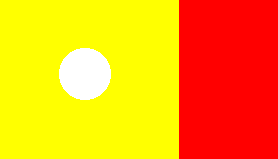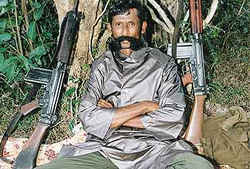
Vishala Tamil Nadu flag |
The Tamil Nadu Liberation
Army (TNLA) has mapped out a self-styled Vishala Tamil
Nadu or Greater Tamil Homeland. In addition to the Indian
state of Tamil Nadu and certain other Dravidian speaking
regions of India including the Laccadive Islands, the
Vishala incorporates Minicoy Island, the 'Tamil Eelam'
in Sri Lanka, the whole of the Maldives, Malaysia and
Singapore ('Malayanadu'), and Mauritius. This was reported
by S. Anand in Outlook
India issue of 20 October 2003.
Maybe Maldives will be
called something like 'Maalh-diu Nadu', but the TNLA
seem to have left that up to our imagination.
The Indian territories
the TNLA is claiming, were under the sovereignty of
the Madras Presidency of the British East India Company.
Malaysia and Singapore
have significant minorities of Tamil speaking people,
as does Mauritius.
But
why is Maldives included in the TNLA claims to an enduring
Dravidian empire?
|
The origins of the TNLA can be
traced to Pulavar Kaliyaperumal, a former school
teacher and a left-wing extremist, Naxalite, leader.
Within the Naxal ranks, he commenced a debate
on Tamil nationalism, which led to differences
of opinion between the Tamil Nadu unit and the
all-India unit of the Communist Party of India--Marxist-Leninist
(CPI-ML). While prominent Naxalite leaders in
the State of Tamil Nadu like Pulavar Kaliyaperumal,
Thamizharasan and Anbazhagan alias Sundaram advocated
a separate Tamil Nadu, the all-India leadership
rejected the idea. This led to a formal split
in the CPI-ML and the formation of Tamil Nadu
Communist Party-Marxist-Leninist (TNCP-ML) in
1984-85. The TNCP-ML's armed wing was named TNLA.
Sundaram headed the TNCP-ML and Thamizharasan,
an engineering student from Ponparappi village,
headed the TNLA.
|
Mohamed Thakurufan, Kateeb
of Uteem who rebelled against Andiri Andirin, the legitimate
regent of King Manoel Siri Dhirikusa Loka in the 16th
century, promised to cede sovereignty of the Maldives
to the Ali Raja of Cannanore. This was mentioned in
a letter sent by a later Ali Raja, Mariambe Ali-Adi
Raja Bibi, to the Sultan Mohamed Mueenuddine I of the
Maldives. The letter was dated Friday 17 Jamada-el-oula
Anno Hegirae 1243 (7 December AD 1827). The Ali Rajas
of Cannanore were Muslim rulers who spoke a Dravidian
language like Tamil. TNLA may be renewing the old territorial
claim of the Ali Rajas based on the Uteem Kateeb's promise.
In 1988 a group of Maldive
nationals invaded Malé with the help of Tamil mercenaries.
This attempted coup failed when Indian troops were deployed
at the invitation of the Maldive regime. Since then
a secret military protection pact has existed between
the Maldives and India. Certain Indian military maps
now include the Maldives within the jurisdiction of
the Indian Army's southern command based in Bangalore.
Bangalore is within the area claimed for Vishala Tamil
Nadu.
Sri Lankan (Muslim) Moors
are Tamil speakers. Tamil and other Dravidian languages
are the native tongues of most southern South Asian
Muslims. This may be another reason why the Maldives
is included as part of Vishala Tamil Nadu.
The Maldive regime claims
that the Maldives has a 100% Muslim population.
The Divehi language of
the Maldives and Minicoy is not a Dravidian language
like Tamil or Malayalam. It is an Indo-European language
akin to Farsi, Kurdish, the northern Indian languages
and Sinhala of Sri Lanka. Like Sinhala, Divehi has some
Dravidian influence in its vocabulary, but recent linguistic
research has proved conclusively that Divehi shares
the same root language as Sinhala. The Maldivian language
developed, concurrently with Sinhala, on the basis of
that original non-Dravidian language. The Maldive people
share some cultural values and practices with the Dravidians.
Nevertheless, this does not warrant a Tamil claim over
the Maldives especially when the Sinhala-speaking areas
of Sri Lanka seem to be spared.
|
Maldive
broadcaster comments
"I am convinced that Tamil culture
and Maldivian (including Sinhala) culture are
incompatible. I am sure those incompatibilities
are at the heart of the civil war in Sri Lanka.
"The biggest difference between Tamil and
Maldivian culture is that Tamils arrange their
kids' marriages, putting great emphasis on advertising
their kids in newspaper ads, through brokers,
and so on. Then they spend an enormous amount
of money on a lavish, huge marriage party and
on buying large quantities of gold to show off
to the others. That is the hallmark of their culture
and much hype and all their preoccupations are
centred on this 'proper marriage' obsession. This
marks deeply their behaviour and way of life.
"Maldivians mock and ridicule Tamil obsessions,
in videos and songs, where a Maldivian young man
dresses like a Tamil, with a big moustache and
in unfashionable clothes, and a girl dresses like
a Tamil woman, with a sari and pretending she
is so shy and virtuous putting up a silly smile.
Maldivians live in a more open and less pretentious
society and they think that Tamils are ever so
busy trying to show off and pretend they are what
they are not, that they don't know how to enjoy
life.
"In Maldivian (and Minicoyan) society parents
play no role in marriage arrangements. Young men
and women are free to choose their own partners.
Dowry and female child foeticide are unknown things
in Maldives and Minicoy. This permeates the whole
of their social attitudes and makes Maldivian
society so different from Tamil society as day
and night. This enormous incompatibility of mores
makes the claim of Vishala Tamil Nadu on Maldives
misinformed, ignorant and ridiculous. How could
such two totally different peoples be part of
the same nation?"
|
Pebbles in a tin can
The
annual Maldive embassy to Ceylon (Sri Lanka)
was an ancient ceremony probably dating back
to the time of the kings of Kotté in Southern
Sri Lanka. It survived through Portuguese, Dutch
and British rule on Ceylon. Maldive ambassadors
were accredited to whoever ruled in southern
Ceylon.
The Maldives did not maintain a permanent diplomatic
mission in Sri Lanka until the early 1920s,
when it was established by order of King Siri
Kula Sundhura Katthiri Bawana (Mohamed Shamsuddine
III) and accredited to the governor of King
George V. For well over a century, until the
late 1940s, it was the British governor who
received the Maldive ambassadors. However, the
proceedings connected with this ceremony resembled
the way foreign ambassadors were received at
the court of the kings of Kotté.
The missives addressed to the ruler of Colombo/
Kotté were written in Divehi and affixed with
the Katthiri Mudhi (Seal of the Maldive
Kings).
At the colourful state ceremony in Colombo to
receive the Maldive ambassador, the latter would
speak in Divehi and would be translated to Arabic
by a Maldive interpreter. The Arabic would then
be translated to Sinhala, Portuguese, Dutch
or English (depending on the official language
of Sri Lanka at the time) by a Moor. The Moors
were Tamil speakers.
At some stage it was decided to eliminate the
Arabic and the Maldive king sent abroad someone
to learn Tamil. When the person returned after
learning Tamil, the king summoned him and ordered
him to say a few words in Tamil to find out
what the language sounded like.
"Your Majesty", replied the interpreter following
a perfectly executed kurunees salute, "if you
place a lot of pebbles in a tin can and shake
it, that would be Tamil for you sire".
|

Nakkheeran |
Veerappan
(pictured above) puts TNLA on separatist world map
|

